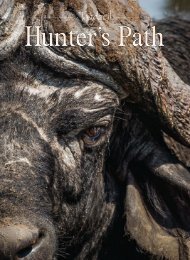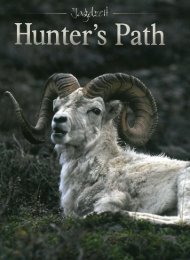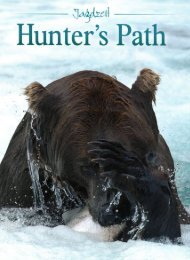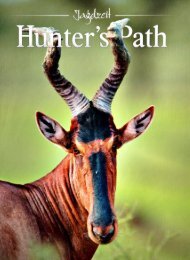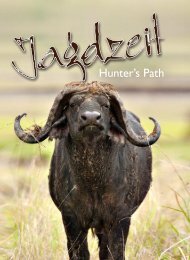Create successful ePaper yourself
Turn your PDF publications into a flip-book with our unique Google optimized e-Paper software.
as quickly as possible and slow down the<br />
decomposition process. Skinning is best done<br />
when the animal is still fresh, just after it has<br />
been killed. The easiest and most comfortable<br />
way is to hang it by its head or hind legs<br />
from a tree. If it is too heavy, it can be skinned<br />
on the ground. The main cut is made from<br />
the middle of the lower jaw across the bottom<br />
of the throat and chest or breastbone,<br />
across the middle of the stomach between<br />
the hind legs, around the anus to the tip of<br />
the tail. The second cut should be between<br />
the front legs, from hoof to hoof or paw to<br />
paw across the chest. The third cut is from<br />
one hind leg to the other across the groin<br />
area. Then you can peel the skin from these<br />
main cuts outwards towards the back. Most<br />
animals, regardless of size, are handled basically<br />
the same way, even frogs and reptiles.<br />
Skinning can take a lot of energy and time,<br />
so if you are not going to make use of the<br />
entire carcass you can take the select parts,<br />
such as the backstraps and buttocks, with<br />
skin and all. The hide will protect the meat<br />
from dust and flies.<br />
GUTTING<br />
When gutting, one of the most important<br />
things is to be careful not to pierce the stomach,<br />
intestines, or bladder. If these organs are<br />
punctured the edible parts may be contaminated<br />
with urine or feces, which will give the<br />
meat an unpleasant taste. Open the carcass<br />
by slitting the throat down to the chest and<br />
cutting through the breastbone. Continue by<br />
carefully slitting open the stomach muscle<br />
from the chest to the anus. Then the entrails<br />
can be pulled out by grabbing the windpipe<br />
and pulling it towards the hind legs, while<br />
cutting it loose where it is attached to the<br />
backbone and inside of the ribcage. Do not<br />
skin and gut any animals close to your shelter,<br />
because this will attract predators and insects.<br />
armpit. The hind legs can be separated from<br />
the pelvis by pulling the leg away from the<br />
body while cutting through the groin along<br />
the pelvis. The neck, ribs and back can be<br />
cut into smaller pieces by cutting between<br />
joints. A panga or machete can also be used<br />
to chop through the bones, but this will<br />
create small bone fragments. If the whole<br />
carcass is not going to be used, the prime<br />
cuts are the fillets on the inside of the body<br />
and the backstraps on the outside parallel<br />
to the backbone.<br />
EATING RAW MEAT<br />
Raw meat can be eaten but will take longer<br />
to digest. Your body will also use more water<br />
to digest it, and that can result in thirst. So be<br />
careful not to eat a lot of raw meat when you<br />
do not have sufficient water. One particular<br />
part of the carcass that can be eaten raw is<br />
the liver of herbivores. It will not take a lot<br />
of energy to digest because it is very tender<br />
and also very palatable, with a sweet, pleasant<br />
taste. Start by removing the gallbladder<br />
carefully without contaminating the meat<br />
with bile. Then pull off the thin membrane<br />
covering the liver, squeeze out the blood by<br />
pressing it between your hands, cut it into<br />
small bite-sized chunks, and enjoy a lovely<br />
wilderness sushi. Eating raw liver is a good<br />
option when you do not have a fire, but it<br />
does taste better cooked. You can place it<br />
directly on hot coals, like the bushmen do.<br />
Avoid the liver of predators and any with<br />
obvious parasites or white spots.<br />
Preparation<br />
of Plants<br />
LEAVES<br />
The green, soft, young leaves and shoots of<br />
some plants can be a substitute for green<br />
vegetables, but some are hard, unpalatable<br />
and difficult to digest. Try to collect young<br />
leaves at the tip or growth-points of edible<br />
plants like the pigweed (marog), Commelina,<br />
baobab (Adansonia digitata) and cabbage trees<br />
(Cussonia species). These are discussed in<br />
more detail in the Survive installment dealing<br />
with edible plants. The best way to cook<br />
leaves is to cut them into small pieces, removing<br />
all the hard parts like the stems, and<br />
then to boil them until soft. You can change<br />
the water a few times to get rid of the bitter<br />
taste, and also add meat and bones to<br />
improve the taste.<br />
FRUIT AND FLOWERS<br />
Wild fruit is usually more sour or bitter<br />
than sweet, often there is not a lot of flesh,<br />
and it usually is a case of more kernel than<br />
fruit. Although wild fruit can be eaten raw,<br />
boiling it will improve palatability and take<br />
the sting out of the taste. It will also make<br />
it more digestible, especially if you can only<br />
Flower petals, such as those of water lilies, are edible.<br />
CUTTING UP THE CARCASS<br />
The carcasses of larger animals can be cut<br />
up into smaller portions to make for easier<br />
carrying and cooking. The shoulders can<br />
be separated from the chest by pulling the<br />
leg away from the body while cutting between<br />
the shoulder and chest through the<br />
27





